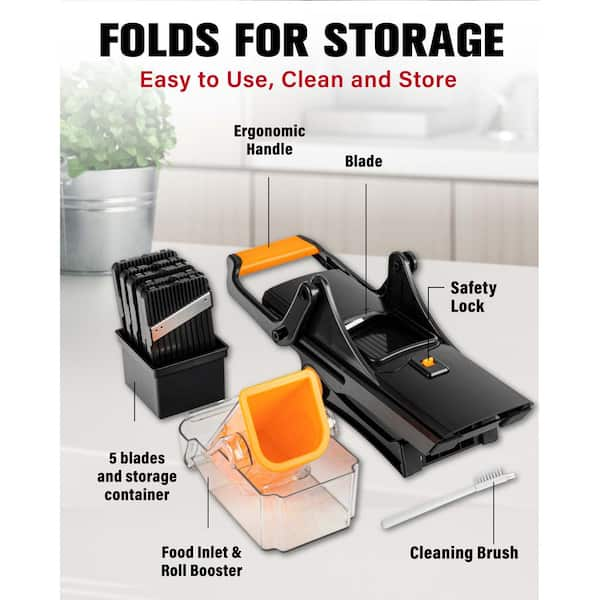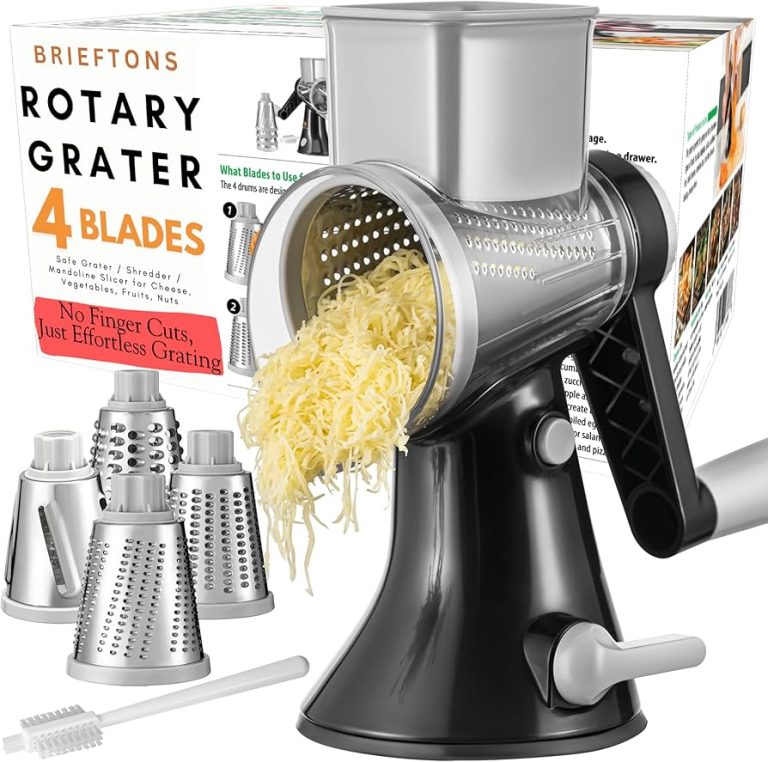Have you ever sliced vegetables with your mandoline and marveled at the precision of each cut? The secret lies in the sharpness of those blades.
But keeping them in top condition requires more than just a rinse under the tap. If you want your mandoline to continue delivering perfect slices while ensuring your kitchen safety, knowing how to clean and store its blades is crucial.
Imagine effortlessly slicing through veggies every time, without the worry of dull blades or hidden food residues. Your culinary creations deserve nothing less than perfection. Dive into this guide, and discover how to maintain your mandoline blades like a pro. You’ll be amazed at how simple it is to ensure your kitchen tool remains a trusty ally in your cooking adventures.
Mandoline Blade Basics
Mandoline blades are essential tools for slicing vegetables with precision. Understanding the basics of these blades helps in maintenance and storage. Keeping them clean ensures they remain effective and safe to use. Proper storage prevents damage and prolongs their lifespan. Let’s dive into the different types and materials of mandoline blades.
Types Of Mandoline Blades
Mandoline blades come in various forms for different cuts. The straight blade is the most common. It slices vegetables into even, thin pieces. Then there’s the julienne blade. It creates thin strips, perfect for salads. Crinkle-cut blades add a wavy texture to your slices. Some mandolines also feature waffle-cut blades. They create a crisscross pattern, ideal for decorative dishes.
Common Materials Used
Mandoline blades are made from different materials. Stainless steel is the most popular choice. It’s durable, rust-resistant, and maintains sharpness. Carbon steel is another option. It stays sharp longer but requires more care. Some blades use ceramic. They’re light and sharp but can chip easily. Knowing your blade’s material helps in cleaning and maintaining it properly.
Safety Precautions
Cleaning and storing mandoline blades require careful attention. Ensuring safety is crucial. Sharp blades can pose a risk if mishandled. By following safety precautions, you can keep yourself protected. Let’s explore how to handle these tools safely.
Handling Sharp Blades
Always approach sharp blades with caution. They can easily cut through skin. Hold blades by their edges, not the sharp side. Use a soft cloth to clean. Avoid direct contact with fingers. Place blades on a flat surface when not in use. This minimizes the risk of accidents.
Using Protective Gear
Wear gloves designed for handling sharp objects. They provide an extra layer of safety. Protective gloves reduce the chance of cuts. Ensure the gloves fit well. Loose gloves can be hazardous. Use blade guards when storing. They cover the sharp edges effectively. Keep blades in a secure container. This prevents accidental exposure.
Cleaning Techniques
Cleaning mandoline blades is crucial for maintaining their sharpness and longevity. Proper cleaning prevents food buildup and ensures safe food preparation. Learn effective techniques to clean your mandoline blades thoroughly. Choose the best method for your needs.
Dishwasher Vs Handwashing
Many mandoline blades are dishwasher-safe. Check the manufacturer’s instructions first. Dishwashers offer convenience but can dull blades over time. Handwashing is more gentle and preserves blade sharpness. Use warm soapy water and a soft brush. Rinse thoroughly to remove all soap.
Removing Stubborn Residue
Some foods leave stubborn residue on mandoline blades. To tackle this, soak the blades in warm, soapy water. Allow them to sit for a few minutes. Use a soft brush or sponge to scrub away residue. Baking soda paste can help with tough stains. Apply gently, then rinse well.

Credit: www.amazon.com
Storage Solutions
Proper storage of mandoline blades keeps them sharp and ready. It also prevents accidents and prolongs the blades’ lifespan. Finding the right storage method requires consideration and care.
Choosing The Right Container
Select a container that fits your mandoline blades snugly. A tight fit prevents movement and potential damage. Use a container with a secure lid to keep the blades safe. Plastic or metal containers work well for storage. Ensure the container is clean and dry before use.
Preventing Rust And Damage
Moisture is the enemy of mandoline blades. Always dry blades thoroughly before storing. Use silica gel packs to absorb any excess moisture. Consider oiling blades lightly to prevent rust. This creates a protective barrier against humidity.
Store blades in a cool, dry place away from humidity. Keep them separate from other kitchen tools to avoid nicks or scratches. Using blade guards can provide an extra layer of protection. This simple step can ensure your blades stay in top condition.
Maintenance Tips
Properly clean and dry mandoline blades after use to prevent rust. Store them in a dry, safe place. Use blade guards or a soft cloth to protect them from damage.
Maintaining your mandoline blades can extend their lifespan and ensure your kitchen adventures remain safe and efficient. Proper care of these blades involves regular inspection and sharpening, preventing any mishaps during food preparation. This section will guide you through essential maintenance tips, highlighting how these simple actions can improve both your kitchen skills and your cooking experience.Regular Inspection
Regularly inspecting your mandoline blades is crucial for identifying any wear and tear. Check for any dull edges or rust spots. These can affect the performance and safety of your mandoline. After each use, take a close look at the blades. This helps in spotting any potential issues early on. You wouldn’t want a surprise when slicing your vegetables! It’s also wise to inspect the blade alignment. Make sure they are properly positioned to avoid uneven slicing. Have you ever tried cutting carrots only to end up with uneven pieces? A quick inspection can prevent that.Sharpening Methods
Sharpening your mandoline blades is essential to keep them in top condition. A sharp blade not only makes slicing easier but also safer. Dull blades can slip and cause injuries. You can use a sharpening stone or a honing rod to sharpen your blades. These tools are user-friendly and effective. If you’ve never used them, don’t worry. They usually come with instructions. Alternatively, consider professional sharpening services. Many local kitchen stores offer this service. It’s an excellent option if you’re unsure about doing it yourself. Have you ever wondered how often you should sharpen your blades? It’s often best to sharpen them after several uses, depending on how often you use your mandoline. Regular sharpening ensures your cuts are always clean and precise. By taking these steps, you’re investing in the longevity of your mandoline. Have you ever tried to slice through a tomato with a dull blade? It’s frustrating and messy! Regular maintenance eliminates such hassles. What other tools do you regularly maintain in your kitchen? Could these tips apply to them too?
Credit: betterware.com
Expert Advice
Cleaning and storing mandoline blades can be tricky. They require special care to ensure their longevity and performance. Experts emphasize the importance of regular maintenance. This keeps your blades in top condition. Let’s dive into expert advice on this matter.
Common Mistakes To Avoid
Many users make the mistake of leaving blades wet. This can lead to rust. Always dry them completely after washing. Avoid using abrasive sponges. They can scratch the blade surface. Instead, use a soft cloth or sponge. Another common error is storing blades loosely. This can cause them to dull or chip. Store them in a protective case or sheath.
Recommended Products
Experts recommend specific products for cleaning mandoline blades. A mild dish soap works best for washing. It removes food particles without harming the metal. For drying, microfiber cloths are ideal. They absorb water quickly and leave no lint. Consider blade guards for safe storage. They protect the edges and prevent accidents. Another useful product is a blade organizer. It keeps your blades sorted and secure.

Credit: www.homedepot.com
Frequently Asked Questions
How Do You Clean A Mandoline Blade?
Clean the mandoline blade carefully using warm water and mild soap. Use a soft brush for scrubbing. Rinse thoroughly and dry with a clean towel. Avoid abrasive cleaners to prevent damage. Regular cleaning ensures longevity and safe use.
How To Clean Once For All Mandolins?
Clean mandolins by wiping with a damp cloth. Use mild soap for tough spots. Dry immediately with a soft cloth. Avoid soaking or immersing in water. Regular maintenance keeps mandolins in top condition.
Should You Use Soap On A Mandolin?
Avoid using soap on a mandolin. Soap can damage the wood and affect sound quality. Use a dry or slightly damp cloth for cleaning. Regular maintenance ensures optimal performance and longevity. Always handle your mandolin with care to preserve its integrity and sound.
What Are The Safe Operating Practices Of Mandolin Slicer?
Use a hand guard to protect fingers. Secure the slicer on a stable surface. Adjust blade settings carefully. Slice slowly and evenly to prevent accidents. Clean the slicer after each use to maintain hygiene.
Conclusion
Keeping mandoline blades clean ensures better performance and safety. Regular cleaning prevents food buildup and dullness. Use warm soapy water to wash them gently. Thoroughly dry the blades to avoid rust. Store them in a safe, dry place. A protective case or sheath works best.
Organized storage keeps blades sharp and ready to use. With these steps, your mandoline stays efficient. Enjoy slicing with ease and precision. Happy cooking!


